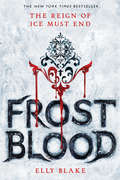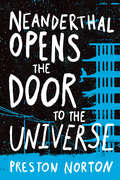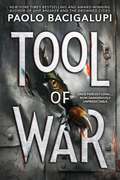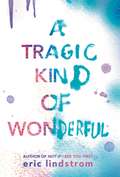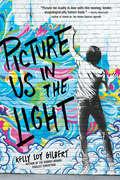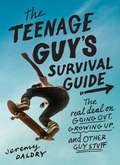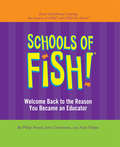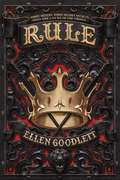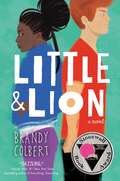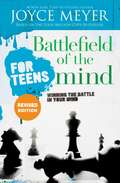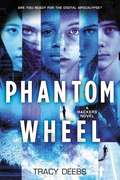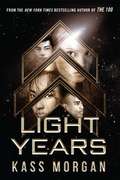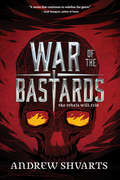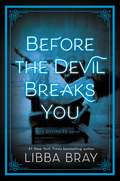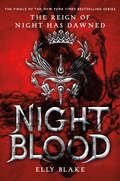- Table View
- List View
Hello, Sunshine
by Leila HowlandA Prep School Girl with a Hollywood DreamBecca Harrington is a reject. After being rebuffed by every college on her list, she needs a fresh start, so she packs up everything and moves to LA, giving herself one year to land an acting gig or kill herself trying. Unfortunately, not everything turns out as planned, and after a few grueling months, LA is looking like the worst idea ever. As hard as she tries, Becca can't land an agent, she's running out of cash, and her mom is hounding her to apply to more schools. In an act of desperation, Becca and her friend Marisol start posting short videos online-with the help of their adorable filmmaker neighbor, Raj-and the videos catch the attention of a TV producer. Could this be it? Her big break? Or will she have to move back home with nothing but some bad head shots and a monstrous credit-card bill? Becca may not get the Hollywood ending she was hoping for, but perhaps she'll learn there's more than one way to achieve her dream.Readers will love every page of this funny, romantic, aspirational, and ultimately triumphant novel about a girl who just wants to make it on her own. Praise for Nantucket Blue"[Howland] evokes the Nantucket setting vividly . . . when it comes to indulgent beach reading, sometimes it's more fun to get pushed over by a wave than to stay safely on your towel." -The New York Times "Sand, secrets, Nantucket Reds, and romance. A fresh, feel-good debut." -The Boston Globe Praise for Nantucket RedEnjoyable and introspective, this is more than just a summer beach read." -Kirkus Reviews
Frostblood (The Frostblood Saga #1)
by Elly Blake<P>The Frost King will burn. <P>Seventeen-year-old Ruby is a Fireblood who has concealed her powers of heat and flame from the cruel Frostblood ruling class her entire life. But when her mother is killed trying to protect her, and rebel Frostbloods demand her help to overthrow their bloodthirsty king, she agrees to come out of hiding, desperate to have her revenge. <P>Despite her unpredictable abilities, Ruby trains with the rebels and the infuriating--yet irresistible--Arcus, who seems to think of her as nothing more than a weapon. But before they can take action, Ruby is captured and forced to compete in the king's tournaments that pit Fireblood prisoners against Frostblood champions. Now she has only one chance to destroy the maniacal ruler who has taken everything from her--and from the icy young man she has come to love. <P>Vivid and compelling, Frostblood is the first in an exhilarating series about a world where flame and ice are mortal enemies...but together create a power that could change everything. <P><b>A New York Times Bestseller</b>
Wildman
by J. C. Geiger"How can a total stranger understand you better than the people you've known your entire life?"When Lance's '93 Buick breaks down in the middle of nowhere, he tells himself Don't panic. After all, he's valedictorian of his class. First-chair trumpet player. Scholarship winner. Nothing can stop Lance Hendricks.But the locals don't know that. They don't even know his name. Stuck in a small town, Lance could be anyone: a delinquent, a traveler, a maniac. One of the townies calls him Wildman, and a new world opens up.He's ordering drinks at a roadhouse. Jumping a train. Talking to an intriguing older girl who is asking about his future. And what he really wants. As one day blurs into the next, Lance finds himself drifting farther from home and closer to a girl who makes him feel a way he's never felt before-like himself.This debut novel by a remarkable new talent explores the relationship between identity and place, the power of being seen, and the speed at which a well-planned life can change forever.
Username: Regenerated
by Joe SuggThe second book by YouTube star Joe Sugg, Username: Regenerated picks up after the events of Username: Evie. In it, Evie is coming to terms with e.scape's reboot and the loss of avatar Lionel. She is desperate to gain access to the virtual reality again and pretends to have feelings for real-world Lionel so he'll fix the program. When he discovers that she's using him, real-world Lionel deletes e.scape in a fit of anger. Immediately regretting what he's done, he finds an older version, reboots it, and inadvertently brings an earlier virtual reality back to life. Meanwhile, in the e.scape, avatar Lionel befriends one of the brutes. After the reboot, the brute finds a computer that allows him to escape to the real world. Once he's gone, avatar Lionel quickly discovers what happened and goes after his friend. The two stories become intertwined with old friends reunited, new dangers faced, and Evie confronting a part of her past that she thought was long gone.
Neanderthal Opens the Door to the Universe
by Preston NortonPerfect for fans of John Green and Becky Albertalli, Neanderthal Opens the Door to the Universe is a "sneakily thought-provoking" and "utterly unforgettable" must-read for every fan of contemporary YA. Cliff Hubbard is a huge loser. Literally. His nickname at Happy Valley High School is Neanderthal because he's so enormous-6'6" and 250 pounds to be exact. He has nobody at school, and life in his trailer-park home has gone from bad to worse ever since his older brother's suicide. There's no one Cliff hates more than the nauseatingly cool quarterback Aaron Zimmerman. Then Aaron returns to school after a near-death experience with a bizarre claim: while he was unconscious he saw God, who gave him a list of things to do to make Happy Valley High suck less. And God said there's only one person who can help: Neanderthal. To his own surprise, Cliff says he's in. As he and Aaron make their way through the List, which involves a vindictive English teacher, a mysterious computer hacker, a decidedly unchristian cult of Jesus Teens, the local drug dealers, and the meanest bully at HVHS, Cliff feels like he's part of something for the first time since losing his brother. But fixing a broken school isn't as simple as it seems, and just when Cliff thinks they've completed the List, he realizes their mission hits closer to home than he ever imagined. Razor sharp, moving, and outrageously funny, Neanderthal Opens the Door to the Universe is an unforgettable story of finding your place in an imperfect world.
Internment
by Samira AhmedRebellions are built on hope. <P><P>Set in a horrifying near-future United States, seventeen-year-old Layla Amin and her parents are forced into an internment camp for Muslim American citizens. <P><P>With the help of newly made friends also trapped within the internment camp, her boyfriend on the outside, and an unexpected alliance, Layla begins a journey to fight for freedom, leading a revolution against the internment camp's Director and his guards. <P><P>Heart-racing and emotional, Internment challenges readers to fight complicit silence that exists in our society today. <P><b>A New York Times Bestseller</b>
Tool of War (Ship Breaker)
by Paolo BacigalupiThis third book in a major series by a bestselling science fiction author, Printz Award winner, and National Book Award finalist is the gripping story of the most provocative character from his acclaimed novels Ship Breaker and The Drowned Cities.Tool, a half-man/half-beast designed for combat, is capable of so much more than his creators had ever dreamed. He has gone rogue from his pack of bioengineered "augments" and emerged a victorious leader of a pack of human soldier boys. But he is hunted relentlessly by someone determined to destroy him, who knows an alarming secret: Tool has found the way to resist his genetically ingrained impulses of submission and loyalty toward his masters... The time is coming when Tool will embark on an all-out war against those who have enslaved him. From one of science fiction's undisputed masters comes a riveting page-turner that pulls no punches."Suzanne Collins may have put dystopian literature on the YA map with 'The Hunger Games'...but Bacigalupi is one of the genre's masters, employing inventively terrifying details in equally imaginative story lines." --Los Angeles Times
A Tragic Kind of Wonderful
by Eric LindstromIn the vein of It's Kind of a Funny Story and All the Bright Places, comes a captivating, immersive exploration of life with mental illness.For sixteen-year-old Mel Hannigan, bipolar disorder makes life unpredictable. Her latest struggle is balancing her growing feelings in a new relationship with her instinct to keep everyone at arm's length. And when a former friend confronts Mel with the truth about the way their relationship ended, deeply buried secrets threaten to come out and upend her shaky equilibrium.As the walls of Mel's compartmentalized world crumble, she fears the worst--that her friends will abandon her if they learn the truth about what she's been hiding. Can Mel bring herself to risk everything to find out?In A Tragic Kind of Wonderful, Eric Lindstrom, author of the critically acclaimed Not If I See You First, examines the fear that keeps us from exposing our true selves, and the courage it takes to be loved for who we really are.
Picture Us In The Light
by Kelly Loy Gilbert"Picture me madly in love with this moving, tender, unapologetically honest book."-Becky Albertalli, #1 best-selling author of Simon Vs. the Homo Sapiens Agenda Winner of the California Book Award and Stonewall Honor! Danny Cheng has always known his parents have secrets. But when he discovers a taped-up box in his father's closet filled with old letters and a file on a powerful Bay Area family, he realizes there's much more to his family's past than he ever imagined.Danny has been an artist for as long as he can remember and it seems his path is set, with a scholarship to RISD and his family's blessing to pursue the career he's always dreamed of. Still, contemplating a future without his best friend, Harry Wong, by his side makes Danny feel a panic he can barely put into words. Harry's and Danny's lives are deeply intertwined and as they approach the one-year anniversary of a tragedy that shook their friend group to its core, Danny can't stop asking himself if Harry is truly in love with his girlfriend, Regina Chan.When Danny digs deeper into his parents' past, he uncovers a secret that disturbs the foundations of his family history and the carefully constructed façade his parents have maintained begins to crumble. With everything he loves in danger of being stripped away, Danny must face the ghosts of the past in order to build a future that belongs to him.
Fireblood (The Frostblood Saga #2)
by Elly BlakeIn this action-packed sequel to the New York Times bestselling Frostblood, Ruby must choose between her fiery homeland and the icy king who loves her.Against all odds, Ruby has defeated the villainous Frost King and melted his powerful throne. But the bloodthirsty Minax that was trapped inside is now haunting her kingdom and everyone she loves. The answers to its demise may lie to the south in Sudesia, the land of the Firebloods, and a country that holds the secrets to Ruby's powers and past....Despite warnings from her beloved Arcus, Ruby accompanies a roguish Fireblood named Kai to Sudesia, where she must master her control of fire in a series of trials to gain the trust of the suspicious Fireblood queen. Only then can she hope to access the knowledge that could defeat the rampaging Minax--which grows closer every moment. But as sparks fly in her moments alone with Kai, how can Ruby decide whom to trust? The fate of both kingdoms is now in her hands.
The Healing Power of Mindfulness: A New Way of Being
by Jon Kabat-ZinnDiscover how mindfulness can help you with healing.More than twenty years ago, Jon Kabat-Zinn showed us the value of cultivating greater awareness in everyday life with his now-classic introduction to mindfulness, Wherever You Go, There You Are. Now, in The Healing Power of Mindfulness, he shares a cornucopia of specific examples as to how the cultivation of mindfulness can reshape your relationship with your own body and mind--explaining what we're learning about neuroplasticity and the brain, how meditation can affect our biology and our health, and what mindfulness can teach us about coming to terms with all sorts of life challenges, including our own mortality, so we can make the most of the moments that we have. Originally published in 2005 as part of a larger book titled Coming to Our Senses, The Healing Power of Mindfulness features a new foreword by the author and timely updates throughout the text. If you are interested in learning more about how mindfulness as a way of being can help us to heal, physically and emotionally, look no further than this deeply personal and also "deeply optimistic book, grounded in good science and filled with practical recommendations for moving in the right direction" (Andrew Weil, MD), from one of the pioneers of the worldwide mindfulness movement.
The Teenage Guy's Survival Guide: The Real Deal on Going Out, Growing Up, and Other Guy Stuff
by Jeremy DaldryThe go-to book about growing up for teenage (or soon-to-be teenage) boys everywhere, updated with brand-new content for today's social media-driven world. Why do crushes make a person go crazy?Where is the best place to break up?What's up with bad teenage mustaches?With chapters covering everything from dating, kissing, and shaving, to moods, peer pressure, bullying, and drugs, The Teenage Guy's Survival Guide offers the real deal on everything guys want to know. Author Jeremy Daldry tackles the various issues adolescent boys face with irreverence and true understanding - and without giving them a nervous breakdown.This revised second edition has been updated to address all sexualities, to reflect changes in the way kids hang out and party, and to tackle the myriad of other challenges brought on by today's social media-driven world. Like nothing else in the market, The Teenage Guy's Survival Guide gives kids the advice they need from someone who feels like a big brother.
Schools of Fish!
by John Christensen Philip Strand Andy HalperIt's two minutes to 8:00. Time to put on your tights and cape. As an educator, every time that bell rings, you face dozens of challenges. Students with overwhelming personal and academic needs. Creativity-stifling mandates. Administrivia. Cynicism. Apathy. The things that keep you from being the educator you want to be. The FISH! Philosophy--four simple principles: Be There, Play, Make Their Day, and Choose Your Attitude--has helped educators around the world build more effective, fulfilling relationships that lead to better learning. It is also backed by tons (OK, about a hundred pounds) of research on classroom management. Schools of FISH! is full of inspiring and instructive stories about people just like you--with hopes and challenges just like yours. It's about real-life heroes who give the best in themselves to help their students find the best in themselves. Schools of FISH! offers practical ideas on classroom management. It addresses the issues you deal with every day--improving learning, respect and personal accountability, self-discipline and internal motivation, and finding ways to make learning more fun. Because you're not just teaching students to learn . . . you're inspiring them to want to learn.
Rule: Tres Secretos Mortales (Rule #1)
by Ellen GoodlettThree Dark Crowns meets Pretty Little Liars in this sensational and striking new fantasy from debut author Ellen Goodlett. Three girls. Three deadly secrets. Only one can wear the crown.The king is dying, his heir has just been murdered, and rebellion brews in the east. But the kingdom of Kolonya and the outer Reaches has one last option before it descends into leaderless chaos. Or rather, three unexpected options.Zofi has spent her entire life trekking through the outer Reaches with her band of Travelers. She would do anything to protect the band, her family. But no one can ever find out how far she's already gone.Akeylah was raised in the Eastern Reach, surrounded by whispers of rebellion and abused by her father. Desperate to escape, she makes a decision that threatens the whole kingdom.Ren grew up in Kolonya, serving as a lady's maid and scheming her way out of the servants' chambers. But one such plot could get her hung for treason if anyone ever discovers what she's done.When the king summons the girls, they arrive expecting arrest or even execution. Instead they learn the truth: they are his illegitimate daughters, and one must become his new heir. But someone in Kolonya knows their secrets, and that someone will stop at nothing to keep the sisters from their destiny... to rule. Magic, mystery, and blackmail abound in the first book of this sensational and striking fantasy duology.
Little & Lion
by Brandy ColbertA stunning novel on love, loss, identity, and redemption, from Publishers Weekly Flying Start author Brandy Colbert. When Suzette comes home to Los Angeles from her boarding school in New England, she isn't sure if she'll ever want to go back. L.A. is where her friends and family are (along with her crush, Emil). And her stepbrother, Lionel, who has been diagnosed with bipolar disorder, needs her emotional support.But as she settles into her old life, Suzette finds herself falling for someone new...the same girl her brother is in love with. When Lionel's disorder spirals out of control, Suzette is forced to confront her past mistakes and find a way to help her brother before he hurts himself--or worse. <br> <b>Winner of the 2018 Stonewall Book Award</b>
Mindfulness for All: The Wisdom to Transform the World
by Jon Kabat-ZinnMore than twenty years ago, Jon Kabat-Zinn changed the way we thought about awareness in everyday life with his now-classic introduction to mindfulness, Wherever You Go, There You Are. He followed that up with 2005's Coming to Our Senses, the definitive book for our time on the connection between mindfulness and our well-being on every level, physical, cognitive, emotional, social, planetary, and spiritual. Now, Coming to Our Senses is being repackaged into 4 smaller books, each focusing on a different aspect of mindfulness, and each with a new foreword written by the author. In the fourth of these books, Mindfulness for All (which was originally published as Part VII and Part VIII of Coming to Our Senses), Kabat-Zinn focuses on how mindfulness really can be a tool to transform the world--explaining how democracy thrives in a mindful context, and why mindfulness is a vital tool for both personal and global understanding and action in these tumultuous times. By "coming to our senses"--both literally and metaphorically--we can become more compassionate, more embodied, more aware human beings, and in the process, contribute to the healing of the body politic as well as our own lives in ways both little and big.
My Almost Flawless Tokyo Dream Life
by Rachel Cohn"I'm here to take you to live with your father. In Tokyo, Japan! Happy birthday!"In the Land of the Rising Sun, where high culture meets high kitsch, and fashion and technology are at the forefront of the First World's future, the foreign-born teen elite attend ICS-the International Collegiate School of Tokyo. Their accents are fluid. Their homes are ridiculously posh. Their sports games often involve a (private) plane trip to another country. They miss school because of jet lag and visa issues. When they get in trouble, they seek diplomatic immunity.Enter foster-kid-out-of-water Elle Zoellner, who, on her sixteenth birthday, discovers that her long-lost father, Kenji Takahara, is actually a Japanese hotel mogul and wants her to come live with him. Um, yes, please! Elle jets off first class from Washington, DC, to Tokyo, which seems like a dream come true. Until she meets her enigmatic father, her way-too-fab aunt, and her hyper-critical grandmother, who seems to wish Elle didn't exist. In an effort to please her new family, Elle falls in with the Ex-Brats, a troop of uber-cool international kids who spend money like it's air. But when she starts to crush on a boy named Ryuu, who's frozen out by the Brats and despised by her new family, her already tenuous living situation just might implode.My Almost Flawless Tokyo Dream Life is about learning what it is to be a family, and finding the inner strength to be yourself, even in the most extreme circumstances.
Battlefield of the Mind for Teens: Winning The Battle In Your Mind
by Joyce MeyerMade teen-friendly with contemporary language, BATTLEFIELD OF THE MIND FOR TEENS equips a new audience desperately in need of guidance with a means of winning the war raging inside them.
Phantom Wheel: A Hackers Novel
by Tracy DeebsThe digital apocalypse has arrived and the future is here in this addictive technological thriller full of twists and turns. Perfect for fans of Nerve! Being recruited by the CIA to join a top-secret intelligence program should be the opportunity of a lifetime. For Issa, it's a shot at creating a new and better life for herself and her siblings. For clever con artist Harper, it's a chance to bury the secrets of her troubled past and make sure that those secrets stay buried. But for Owen--honor student, star quarterback, and computer-hacking genius--it sounds like a trap. He's right. Owen discovers that instead of auditioning for the CIA, they've all been tricked by a multibillion-dollar tech company into creating the ultimate computer virus. It's called Phantom Wheel, and it's capable of hacking anyone on Earth, anywhere, at any time. And thanks to six teenagers, it's virtually unstoppable. Horrified by what they've done, the hackers must team up to stop the virus before the world descends into chaos. But working together is easier said than done, especially as the lines start to blur between teammate, friend, and more than friend. Because how do you learn to trust someone when you've spent your entire life exploiting that same trust in others?
Light Years: Light Years Book Two (Light Years Ser. #Bk. 2)
by Kass MorganEnder's Game meets The 100 as hidden secrets and forbidden love collide at an interstellar military boarding school in a new sci-fi series from New York Times bestselling author Kass Morgan. Reeling from the latest attack by a mysterious enemy, the Quatra Fleet Academy is finally admitting students from every planet in the solar system after centuries of exclusivity. Hotshot pilot Vesper, an ambitious Tridian citizen, dreams of becoming a captain--but when she loses her spot to a brilliant, wisecracking boy from the wrong side of the asteroid belt, it makes her question everything she thought she knew. Growing up on the toxic planet Deva, Cormak will take any chance he can get to escape his dead-end life and join the Academy--even if he has to steal someone's identity to do it. Arran was always considered an outsider on icy Chetire, always dreaming of something more than a life working in the mines. Now an incoming cadet, Arran is looking for a place to belong--he just never thought that place would be in the arms of a Tridian boy. And Orelia is hiding a dark secret--she's infiltrated the Academy to complete a mission, one that threatens the security of everyone there. But if anyone finds out who she really is, it'll be her life on the line. These cadets will have to put their differences aside and become a team if they want to defend their world from a cunning enemy--and they might even fall in love in the process. Light Years is the first book in a thrilling and romantic new sci-fi series from the bestselling author of The 100.
War of the Bastards (Royal Bastards #3)
by Andrew ShvartsIn the epic conclusion to the Royal Bastards trilogy, Tilla faces an impossible choice: unthinkable destruction in the name of peace...or an uncertain future that means confronting a terrible past.A year has passed since the fall of Lightspire. The Inquisitor Miles Hampstedt rules Noveris with a blood-soaked iron fist. Tilla and her friends have become hardened rebels in the Unbroken, a band of guerilla fighters hiding out on the fringes of the Kingdom protecting the true queen, Lyriana Volaris. Even as they fight, they know their cause is doomed--that with every passing day Miles's army of Bloodmages spreads across the continent. But at least they have each other...and some halfway-decent drinks. After a daring rescue mission, the group frees two vital prisoners: the Raven, a mysterious informant with a deep personal connection to Tilla, and Syan Syee, a strange girl from the Red Wastes who demonstrates an incredible new kind of magic and speaks of a secret civilization hidden in her isolated homeland. With Miles's forces closing in, a ragtag team sets out on an eleventh-hour mission: form an alliance with Syan's people that could turn the tide of the war. But what they discover in the Red Wastes changes everything, including their very understanding of the magic that runs through Noveris -- magic that has brought the Kingdom to the brink of ruin.
Before the Devil Breaks You: The Diviners Book 3 (The Diviners #3)
by Libba BrayThe Diviners are back in this thrilling and eerie third installment by #1 New York Times bestselling author Libba Bray.New York City.1927.Lights are bright.Jazz is king.Parties are wild.And the dead are coming... After battling a supernatural sleeping sickness that early claimed two of their own, the Diviners have had enough of lies. They're more determined than ever to uncover the mystery behind their extraordinary powers, even as they face off against an all-new terror. Out on Ward's Island, far from the city's bustle, sits a mental hospital haunted by the lost souls of people long forgotten--ghosts who have unusual and dangerous ties to the man in the stovepipe hat, also known as the King of Crows.With terrible accounts of murder and possession flooding in from all over, and New York City on the verge of panic, the Diviners must band together and brave the sinister ghosts invading the asylum, a fight that will bring them fact-to-face with the King of Crows. But as the explosive secrets of the past come to light, loyalties and friendships will be tested, love will hang in the balance, and the Diviners will question all that they've ever known. All the while, malevolent forces gather from every corner in a battle for the very soul of a nation--a fight that could claim the Diviners themselves.Heart-pounding action and terrifying moments will leave you breathless in the third book of the four-book Diviners series by #1 New York Times bestselling author Libba Bray.
Stray (Stray Ser. #1)
by Monica HessePerfect for fans of Black Mirror and Warcross, this suspenseful novel asks what it means to live a life that isn't your own. Lona Sixteen Always has spent most of her life as someone else. Part of a unique virtual reality experiment for troubled kids who have been "rescued" by the government, she spends twenty-three hours a day on the Path, reliving the decades-old, perfectly ordinary memories of a perfectly ordinary boy. Any other life is unimaginable--until one day someone appears on Lona's screen who doesn't belong. Fenn, a boy from her past, has returned to set her free. Lona is wrenched brutally into an existence that is suddenly all her own, one that promises liberty and love, but also holds threatening secrets. And it turns out that there is a heavy price to pay for straying from her assigned path. In Stray, Edgar-award winning master of suspense Monica Hesse brings us a richly imagined speculative world where there are no easy answers--and no easy way out. *This ebook includes bonus excerpts from Monica Hesse's historical fiction novels Girl in the Blue Coat and The War Outside.
Someone Like Me: How One Undocumented Girl Fought for Her American Dream
by Julissa Arcep.p1 {margin: 0.0px 0.0px 14.0px 0.0px; font: 13.0px Times} A remarkable true story from social justice advocate and national bestselling author Julissa Arce about her journey to belong in America while growing up undocumented in Texas.Born in the picturesque town of Taxco, Mexico, Julissa Arce was left behind for months at a time with her two sisters, a nanny, and her grandma while her parents worked tirelessly in America in hopes of building a home and providing a better life for their children. That is, until her parents brought Julissa to Texas to live with them. From then on, Julissa secretly lived as an undocumented immigrant, went on to become a scholarship winner and an honors college graduate, and climbed the ladder to become a vice president at Goldman Sachs.This moving, at times heartbreaking, but always inspiring story will show young readers that anything is possible. Julissa's story provides a deep look into the little-understood world of a new generation of undocumented immigrants in the United States today--kids who live next door, sit next to you in class, or may even be one of your best friends.
Nightblood: The Frostblood Saga (The Frostblood Saga #3)
by Elly BlakeThe explosive finale of the New York Times bestselling Frostblood Saga, perfect for fans of Three Dark Crowns, Red Queen, and A Court of Thorns and Roses.Ruby's world has changed more than she ever could have imagined. She's in love with a powerful Frost King. She's the heir to the Fire Throne. And she may be a Nightblood--the spawn of a vengeful deity hellbent on releasing an imprisoned army of shadowy wraiths. Once freed, these beasts will roam the earth, devouring the spirits of every last person until he or she is nothing but an empty husk.Ruby is able to control the shadows to a degree, even hosting one in her own body. But will this tenuous connection--which threatens to consume her--be enough to hold the beasts back? With time running out, she must bring Frostbloods and Firebloods together to make a stand against an immortal foe more deadly than any she's faced. And the price of peace may be her very life.In this heart-pounding finale of Elly Blake's gorgeously written and action-packed Frostblood Saga, the fate of Frostbloods, Firebloods, and all of humanity is at stake.

